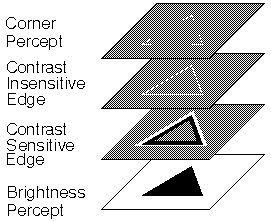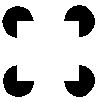Plato's Cave: Hierarchy of Representation
The Hierarchy of Representation
Information theory
suggests a hierarchy of representation in the visual system based on
information compression. I propose therefore a hierarchy as shown
below.

The lowest level of the hierarchy is the filled-in brightness percept,
which corresponds to your view of actual surfaces in the world. The
next level up is an abstraction of that view in the form of a
contrast-sensitive edge representation. The next level is a further
abstraction, in the form of a contrast insensitive edge
representation. Higher levels perform still further abstraction, for
example the edges can be abstracted to corners between edges, and the
corners of a triangle can be abstracted to a tri-angular symmetry from
the center of the triangle, etc. In this scheme each higher level
encodes only the changes in the previous level, resulting in
a compressed representation at the top, while the top-down reification
operation corresponds to an image decompression or reconstruction
operation.
Spatial interactions occur within each layer of the hierarchy, for
example collinear boundary completion in the contrast insensitive
layer, and surface brightness filling-in in the brightness percept
layer, and simultaneous bottom-up abstraction, and top-down
reification transformations occur between the levels of this
hierarchy, so that the entire system responds to a visual input by
relaxing into a global state which is most consistent with the local
interactions active simultaneously at all levels of the hierarchy.
Perception, or consciousness of visual form occurs, I propose,
simultaneously at all levels of the hierarchy (as opposed to only at
the highest levels, as suggested by the
"[Cartesian Theatre]"
concept) although the nature of the percept depends on the
level or levels where it occurs. For example the Kanizsa square shown
below is perceived as a brightness percept as well as a collinearity
percept, so the illusory edges of the square are represented in the
surface brightness percept, the contrast sensitive, and contrast
insensitive edge layers.

The corner grouping percept shown below on the other hand does
not create an illusory brightness percept, although it does
stimulate a percept of collinearity, so the illusory edges of this
figure would be represented only in the contrast insensitive edge
representation.

The level of abstraction does not necessarily correspond to the level
in the visual system. Indeed the retinal image is itself a contrast
sensitive edge representation rather than one of surface brightness.
I propose therefore that the retinal image feeds in to the contrast
sensitive edge layer of the hierarchy, from whence the retinal signal
is both abstracted upwards, and reified downwards by FCS diffusion as
suggested below to the left. Subsequently, the collinear grouping
operation occurs in the contrast insensitive layer (due to the BCS,
Directed Diffusion, or Orientational Harmonic processing), and those
illusory edges are propagated back downwards where they influence the
diffusion of brightness percept in the lowest layer.

This model explains why we perceive surface brightnesses despite the
fact that the retinal image is an edge representation, and it also
explains why the spatial resolution of the primary visual cortex is
about double the resolution of the retina, because the cortical
information is filled-in and refined from the coarser retinal input by
reification, resulting in the phenomenon of hyper-acuity.
Return to argument
Return to Steve Lehar




